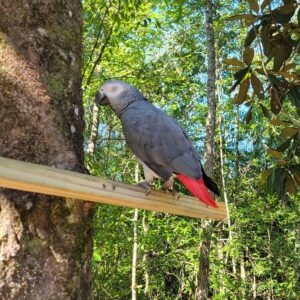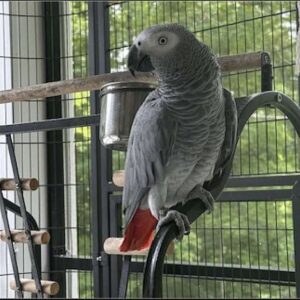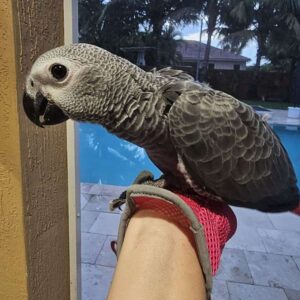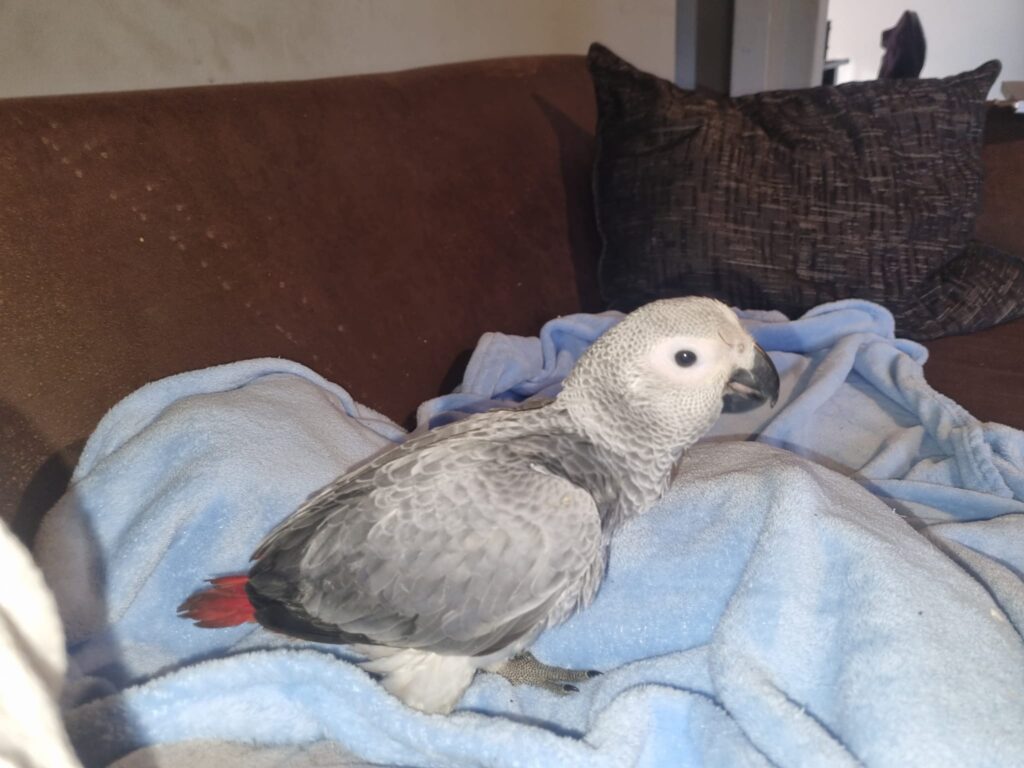
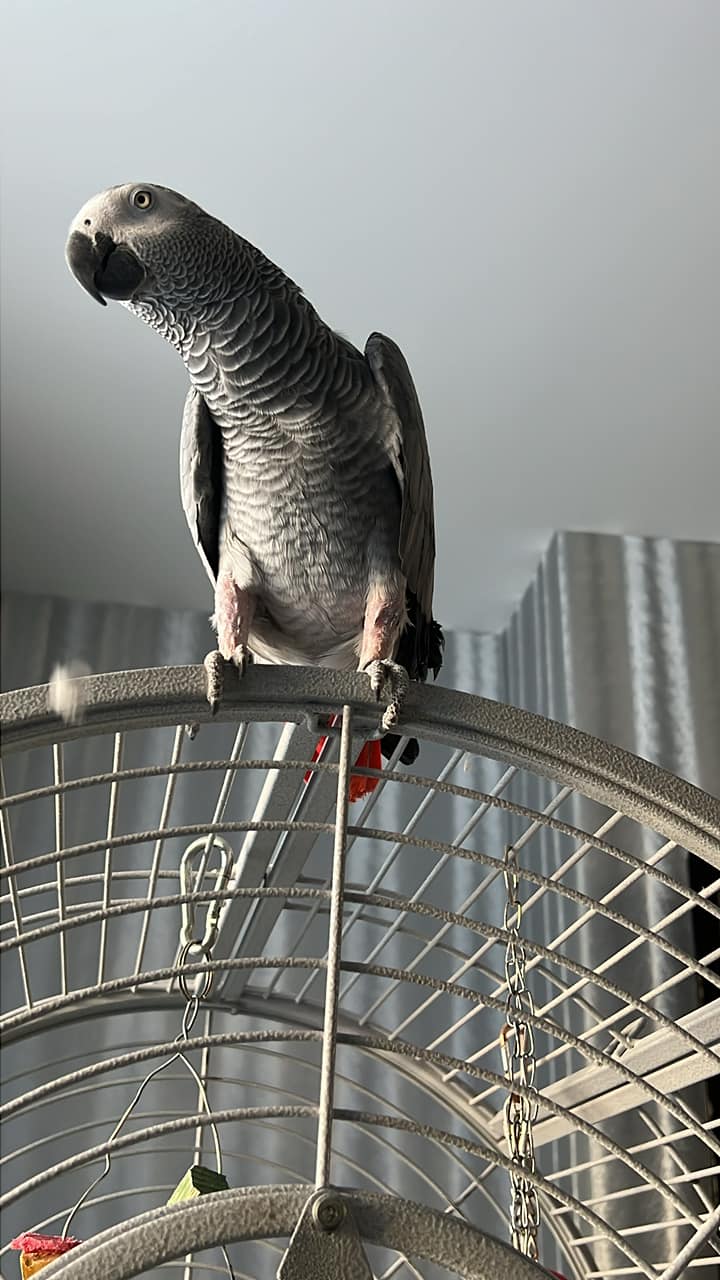
Affordable African Grey Parrot Price.
Known for their impressive intelligence, it is important to offer companion our affordable African Grey Parrot Price a variety of complex toys to engage their active minds and prevent boredom, which can otherwise lead to feather plucking and other bad habits. Some examples include non-destructible hanging toys, push and pull toys, and food-finder toys.
In their natural habitat, Greys spend much of their days flying around, foraging for food. To ensure a healthy, happy parrot at home, Greys require large aviaries a minimum of 3m (9.8 ft) in length, allowing them to stretch their wings and burn off excess energy. African Greys enjoy eating a healthy variety of cooked beans and pulses, fruits and vegetables, spray millet, complete kibble, and other rearing foods.
The African grey parrot is one of the most talented talking/ mimicking birds on the planet, giving it quite a reputation among bird enthusiasts. Not only do bird keepers love this intelligent bird, it’s one of the most recognizable species to bird novices as well — everyone knows the African grey parrot. This parrot is one of the oldest psitticine species kept by humans, with records of the bird dating back to biblical times. Understated beauty and a brainy no-nonsense attitude are what keep this parrot at the peak of popularity.
At first glance, the African grey is a medium-sized, dusty-looking gray bird, almost pigeon-like — but further investigation reveals a bright red tail, intelligent orange eyes, and a stunning scalloped pattern to its plumage.
African grey parrots generally inhabit savannas, coastal mangroves, woodland and edges of forest clearings in their West and Central Africa range. Though the larger of the African grey subspecies is referred to as the Congo African grey, this bird actually has a much wider natural range in Africa, including the southeastern Ivory Coast, Kenya, and Tanzania. The Timneh African grey is found in a smaller region along the western edge of the Ivory Coast and through southern Guinea. Their diet in the wild consists mostly of palm nuts, seeds, fruits, and leafy matter.
There’s a reason why the African grey is often considered the poster bird for parrot intelligence — not only is this bird inclined to amass a large vocabulary, African greys also demonstrate an aptitude for recognizing the meaning of words and phrases.
African greys need plenty of toys that challenge their intelligence, such as foraging and puzzle toys. Nutri-Berries by Lafeber Company are perfect for foraging. This complete food blends a balance of grains, seeds, and other nutrients in the shape of a berry. Because the grains and seeds are mostly whole and formed into a berry shape, it encourages African greys to hold, nibble, and even play with the Nutri-Berries. This mimics the foraging that African greys do in the wild.
African greys seem especially affected by stress and commotion in their environment and can be put more at ease by placing one corner of the cage against a wall as opposed to in the middle of a room.
African grey parrots are more prone to deficiency in vitamin-A/beta-carotene, and therefore benefit from eating vegetables high in beta-carotene, such as cooked sweet potato and fresh kale. Vitamin-D deficiency is another concern, especially for greys on a poor diet. Offering a balanced, pelleted diet, such as Nutri-Berries, for the main diet of an African grey helps prevent vitamin and mineral deficiencies. A grey that consumes a pelleted diet generally does not need vitamin supplements added to its food.
Most bird keepers believe that only an experienced bird enthusiast should keep a grey. They are complex parrots, highly sensitive, and more than a little demanding. They are also charming and brilliant, but this match of sensitivity and brains can lead to behavioral issues. They are creatures of habit, and even a small change in routine can make a sensitive grey unhappy. They are prone to plucking and chewing their feathers, among other bad habits. Anecdotally, the TAG has a hardier attitude and may be better for households with a lot of people coming and going. The CAG prefers a little less chaos.
African greys are social parrots that need a lot of hands-on time, however, they aren’t “cuddlebugs.” They will tolerate some head scratching and a little bit of petting, but they do not appreciate intense physical contact, though some individuals don’t mind a little snuggling. Every bird has individual tastes and preferences. A grey can also become a “one person bird,” even if every member of the household socializes with it from the beginning.
Much of the grey’s appeal comes from its talking ability. It is among the best talkers in the parrot family, able to repeat words and phrases after hearing them just once or twice. This bird reaches full talking ability around a year of age, and most individuals become capable mimics much earlier.
Not only will a grey develop an outstanding vocabulary, research has shown that this species can come to understand what it’s saying. The most famous CAG, Alex, and his colleague, Dr. Irene, may be the reason for the popularity of this species, and certainly for its high profile. Alex and Dr. Pepperberg worked together for 30 years at Brandeis University until his unfortunate death in 2007, due to a catastrophic event associated to arteriosclerosis (“hardening of the arteries”). In their three decades of research, Dr. Pepperberg taught Alex to recognize and identify objects, colors, and shapes. Alex could also understand the concepts of same and different, category, and could even count objects. Though Alex was on his way to much more complex thought processes, including how to read, his fellow African greys Griffin and Arthur (AKA “Wart”) are continuing to work with Dr. Pepperberg trying to reach the point that Alex had reached and even further.
But just because greys are smart and may choose to talk rather than scream, it’s a mistake to believe that they aren’t noisy. They aren’t as loud or persistent as some of the South American species, but they will learn household sounds and use them tirelessly to the dismay of guardians. Imagine the microwave beeping incessantly, or a cellphone ringing madly without the luxury of turning it off.
African greys are especially susceptible to feather picking, calcium deficiency, vitamin-A and vitamin-D deficiency, respiratory infection, psittacosis and psittacine beak and feather disease (PBFD).
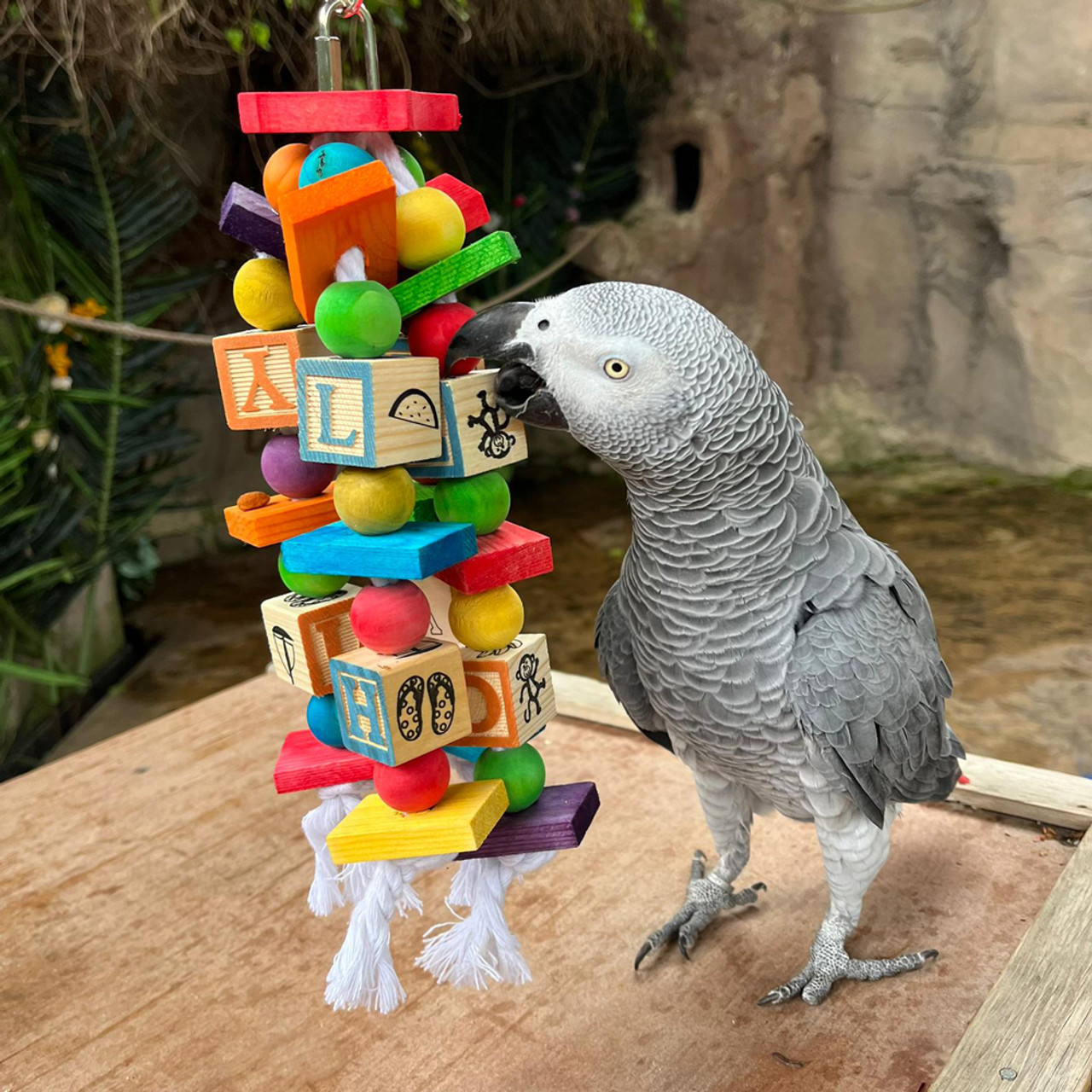
AFRICAN GREY PARROT AVAILABLE
-
African Grey Parrot For Sale
Lidia-Female talking african grey parrot for sale
Rated 0 out of 5400 $ Add to cart -
African Grey Parrot For Sale
Ratio- Male african grey parrot for sale price
Rated 0 out of 5400 $ Add to cart -
African Grey Parrot For Sale
Nanny-Female bird african grey parrots for sale
Rated 0 out of 5400 $ Add to cart -
African Grey Parrot For Sale
Max-Male african Grey Parrot for sale near me
Rated 0 out of 5400 $ Add to cart -
African Grey Parrot For Sale
Male and Female -African Grey Parrot for sale
Rated 0 out of 5400 $ Add to cart
Diet and Nutrition
African grey parrots are mainly frugivorous: they enjoy a diet made of fruits, nuts, bird pellets, and some seeds. You can offer your pet bird fresh fruits and veggies, such as:Pears,Oranges,Apples,Bananas,Carrot,Sweet potatoes,Green beans,Kale and spinach.
The African grey parrot became listed as ‘near threatened’ in 2007 due to its popularity in the pet industry. It is the most popular avian pet in Europe, the US, and the Middle East due to its incredible ability to mimic the human voice as well as its long lifespan. It is thought that up to 21% of the global population is harvested every year. That, combined with the ongoing loss of habitat in Africa, is causing a moderately rapid decline in population.
Climbing up a tree from branch to branch, instead of flying, the African grey collects seeds, nuts, fruit, and berries. These vegetarians are especially fond of eating the outer layer of the oil palm nut as well as the red berries from the Cola tragacantha.They have also developed a taste for grain and can do a great deal of damage to the maize crops planted in western Africa.
The cage of your bird should be ready before arrival . Place it in a pleasant and lively space, such as a living room, because this bird is very friendly and likes to participate in family life. However, avoid a drafty location and close to a window so as not to have direct light. Also, avoid the kitchen because of the smoke – his lungs are fragile – and the bedrooms, which may be too quiet.
His cage should be large enough so that he can spread his wings and fly a little. It should be of solid material, with a complex opening system, because your parrot can quickly learn how to open it!
Install small toys so that he can have fun all day; arrange perches of different sizes. Choose them made of wood so that he can rub his beak on them.
While the African grey parrot may look like a monochrome bird, his plumage features more nuance and subtlety than you might think!
Indeed, the grey parrot’s plumage is not a solid grey. Instead, the feathers on its head and wings are a darker gray, while the feathers on its undercoat are a lighter, more silvery grey. The head feathers are also streaked and tinged with white.
There are a few other splashes of color as well: yellow eyes, black bill, and its tail feathers are bright red. Additionally, mutations can occasionally make parrots red, blue, brown, or albino.
Some breeders have tried to make African grey parrots redder. Their experiments were a success: some parrots are born with all red or all pink plumage instead of grey. Moreover, these specimens are generally sold at astronomical prices because they are so rare!
Also, grey mutations occur naturally in the wild, such as the Blue Ino (all white), the Incomplete Ino (only light pigmentation), and the Blue varietals.
The 6 Nutritional Benefits That Pears Have for Parrots
Sometimes birds are more susceptible to diseases that they may or may not be able to transmit to humans. Pears are high in antioxidants, which help to support the immune system and keep your parrot healthy.
Pears are rich in vitamin C, a powerful antioxidant that helps neutralize free radicals, thus protecting the body from disease processes. Parrots can synthesize their own vitamin C, so additional supplementation is not required, but obtaining it from natural sources helps boost their immunity, making them more resistant to stress and disease.
Magnesium is a key mineral found in pears that helps with bone, muscle, and nerve functions. It plays an important role in many of the enzyme systems in your bird’s body.
In addition to calcium, the phosphorus found in pears plays a key role in forming bones and function.
Phosphorus is crucial for your parrot’s metabolism. It is part of the phospholipids of the cell membrane’s structure.
Potassium is an essential nutrient for the body to function properly. One of its most important jobs is keeping a parrot’s muscles working the way they should, particularly the heart. Potassium has a crucial role in the acid-base balance and maintaining the equilibrium in your parrot’s body.
Vitamin A is an essential nutrient for parrots because many pet birds have a deficiency of this nutrient. This is due to the fact that a lot of pet birds are fed a diet that consists entirely of seeds and nuts, which don’t naturally contain this vitamin.
Feeding fruits and vegetables, including pears, that contain vitamin A to your parrot can help to keep their skin and beak healthy. Vitamin A also helps to maintain mucus membranes around their eyes and nostrils. Without it, your parrot may be more prone to sinus infections and abscesses and in worse cases, deformities.
Last but certainly not least, the vitamin K found in pears works along with potassium to help form blood clots.
All species of parrots can eat pears, but not all species should have the same amount. Pears and fruits in general should never be the main food source for your parrot because fruits lack other nutrients, such as proteins, that are essential to the bird’s health. The number of pears your parrot can eat per week depends on the size, weight, and nutritional needs of the particular species.
The Benefits of Feeding Bananas to Parrots
There are many good reasons to feed bananas as snacks to your pet parrot throughout the week. First and foremost, bananas contain important nutrients that parrots require for long-term good health. This fruit is full of vitamin A, which aids in eye and reproductive health. Parrots tend to be deficient in vitamin A when living in captivity.
Bananas are also loaded with vitamin B6, which is an important nutrient for parrots because it helps them properly digest their food. Without enough vitamin B6, a parrot can suffer from diarrhea, constipation, and malnutrition due to the inability to effectively digest food and nutrients. Magnesium is also present in bananas, which is what helps a parrot grow strong bones and healthy brains.
Can Parrots Eat Banana Peels?
Parrots can eat the peel of a banana, but it is not recommended to offer the peel unless you know exactly where the bananas came from and how they were grown. Most bananas get sprayed with pesticides and other toxins that are dangerous for humans and animals to digest.
Bananas are not easy to scrub clean because scrubbing can break down the peel and ruin the banana inside. Therefore, any pesticides or toxins on the peel would be consumed by your parrot and could potentially cause health problems. Unless you grow the bananas yourself or are confident about where and how they were grown, it is best to remove and discard the peel before serving your parrot any banana.
Can Parrots Eat Banana Chips and Banana Bread?
Parrots should not eat food that includes added sugars, so unless you dehydrate or bake banana chips yourself, they should always be off-limits for your parrot. When it comes to banana bread, your parrot can eat a small amount occasionally. However, make sure that the bread is made with whole grains and natural fruit sweetener instead of white flour and sugar. Any banana bread that your parrot eats should make up a very small percentage of their overall diet.
The 5 Health Benefits of Feeding Apples to Parrots
Apples contain vitamin A, which is needed for several important functions in parrots, including eye health and the general growth and repair of body tissues. It can also play a role in the health and vibrance of your parrot’s feathers.
Apples are loaded with vitamin C, and while parrots don’t need vitamin C in their diet because they produce it from glucose in their liver, it is a great immune booster if your bird is ill or has any liver issues. Vitamin C is also an excellent antioxidant and may aid the gut absorption of important minerals.
Potassium is the principal mineral in apples and is required in your parrot’s diet for glucose and protein metabolism, and it is essential for a healthy nervous system. Too much stress in parrots can easily cause a potassium deficiency, and apples can assist in keeping potassium levels correct
Apples are loaded with healthy fiber, which can help feed the friendly bacteria in your parrot’s gut and control cholesterol and blood sugar levels in their body. Fiber is also great for digestion and helps prevent constipation and loose stools in your parrot.
Apples are around 86% water, so they can be a great additional source of hydration for your parrot.
Testimonials From Customers
"I’m amazed by how quickly my African Grey, Max, learns new words and phrases. He picks up on conversations and can even mimic sounds from the environment. It’s like having a little genius in the house!"
Joyce K. Butts
The intelligence of my African Grey is astounding. Coco has learned to recognize different objects and even solves simple puzzles. It’s incredible to see how their minds work.
Heather J. Larson
Charlie has become a part of our family. He’s very affectionate and loves interacting with us. It’s like having a close friend who is always there for you.
Edward E. Johnson
My African Grey, Bella, is very social and loves spending time with us. She’s a great companion and seems to understand our emotions, which makes her presence even more special
Marvin V. Maciejewski
It’s amazing how well my African Grey, Oliver, can talk. He not only repeats words but also uses them in context. It’s like having a small conversationalist in the house!
Mike R. Stebbins
Luna has an impressive vocabulary and can mimic various sounds. It’s not just the talking; she seems to understand and respond to our conversations, which is fascinating.
Rebecca G. Ritenour
Owning an African Grey is rewarding, but it does come with challenges. They need a lot of social interaction and can be quite loud. It’s worth it for their companionship, though


